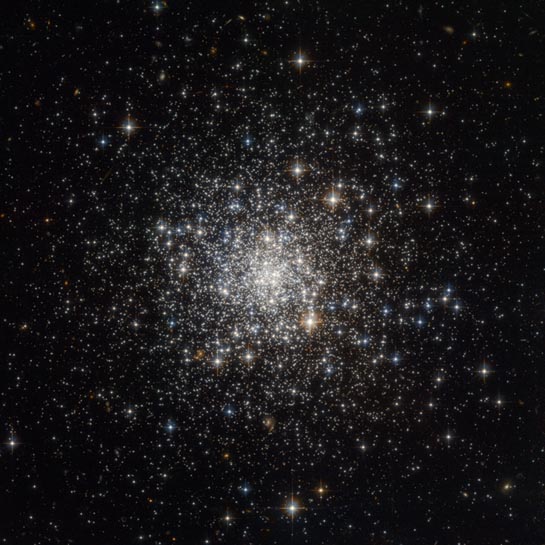
Globular Cluster
RA 12h 10m 06.149s Dec +18° 32' 31.78"
Coma Berenices
60,000 light years
10.74
1.053 x 0.990 50 arcmin
I ESA/Hubble & NASA, T. Sohn et al.
March 7, 2019
ABOUT THIS IMAGE:
This globular cluster, NGC 4147, seen with the NASA/ESA Hubble Space Telescope, was one of many which were used by astronomers to measure the total mass of the Milky Way. NGC 4147 is located about 60,000 light-years from Earth in the northern constellation of Coma Berenices (the Berenice's hair).
The mass of the Milky Way is one of the most fundamental measurements astronomers can make about our galactic home. However, despite decades of intense effort, even the best available estimates of the Milky Way's mass disagree wildly. Now, by combining new data from the European Space Agency (ESA) Gaia mission with observations made with the NASA/ESA Hubble Space Telescope, astronomers have found that the Milky Way weighs in at about 1.5 trillion solar masses within a radius of 129,000 light-years from the galactic center.
Previous estimates of the mass of the Milky Way ranged from 500 billion to 3 trillion times the mass of the Sun. This huge uncertainty arose primarily from the different methods used for measuring the distribution of dark matter - which makes up about 90% of the mass of the galaxy.
"We
just can't detect dark matter directly," explains Laura Watkins (European
Southern Observatory, Germany), who led the team performing the analysis.
"That's what leads to the present uncertainty in the Milky Way's
mass - you can't measure accurately what you can't see!"
Given the elusive nature of the dark matter, the team had to use a clever
method to weigh the Milky Way, which relied on measuring the velocities
of globular clusters - dense star clusters that orbit the spiral disc
of the galaxy at great distances [1].
Notes:
[1]
Globular clusters formed prior to the construction of the Milky Way's
spiral disk, where our Sun and the Solar System later formed. Because
of their great distances, globular star clusters allow astronomers to
trace the mass of the vast envelope of dark matter surrounding our galaxy
far beyond the spiral disk.
From Wikipedia:
NGC 4147 is the New General Catalogue identifier for a globular cluster of stars in the northern constellation of Coma Berenices. It was discovered by English astronomer William Herschel on March 14, 1784, who described it as "very bright, pretty large, gradually brighter in the middle". With an apparent visual magnitude of 10.7, it is located around 60,000 light years away from the Sun at a relatively high galactic latitude of 77.2°.
This is a relatively small globular cluster, ranking 112th in luminosity among the Milky Way globular cluster population. It is considered an Oosterhoff type I cluster (OoI), despite having a relatively low metallicity. Indeed, it has the lowest metallicity of any OoI cluster known. There are 19 RR Lyrae variable star candidates and as many as 23 blue stragglers. A high proportion of the latter are concentrated near the dense core of the cluster, which is consistent with the idea that blue stragglers form through stellar mergers.
The
cluster lies some 70.4 ± 7.5 kly (21.6 ± 2.3 kpc) from the
Galactic Center, and is relatively isolated from other globular clusters
in the galaxy. The position of this cluster makes it a candidate for association
with the Sagittarius tidal stream, and thus it may have been captured
by the Milky Way after separation from the Sagittarius Dwarf Spheroidal
Galaxy. A contour map of the cluster appears to show S-shaped tidal arms
stretching to the north and south for several tidal radii. Such features
are predicted for globular clusters that follow elliptical orbits and
are near their apogalacticon.